What are Montessori Bookshelves?
What are Montessori Bookshelves? Means these are important shelves designed for children in places like schools and homes. These shelves hold books that are carefully chosen to help them to learn and explore the world around them. Montessori bookshelves are set up in a way that makes it easy for kids to pick books they like and read them independently.
Purpose of Montessori Bookshelves
The purpose of Montessori bookshelves is to encourage children to enjoy reading and learning. When kids can easily reach and choose books that interest them, they become excited about reading. Montessori bookshelves also help kids become more independent learners as they pick books and explore new ideas on their own. This helps build a strong foundation for a love of reading that can last a lifetime.
How Montessori bookshelves align with the principles of child-centered learning and independence?
These are like special helpers for children’s learning. They’re set up in a way that lets kids decide which books they want to read. This is important because it puts the child in charge of their learning journey. Instead of someone telling them what to read, they get to choose what interests them. This helps children become active learners who are excited about exploring new things on their own terms.
How Montessori Bookshelves Promote Independence:
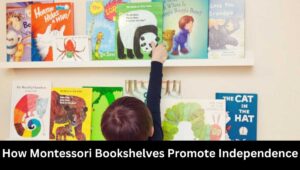
Montessori bookshelves are made with kids in mind. They’re designed to be easy for children to use by themselves. Children can reach the books and take them out whenever they want. This helps kids learn how to do things on their own, like picking out a book when they’re curious or want to know something new. By giving kids this freedom to choose and explore, Montessori bookshelves teach them to be independent and confident in their abilities.
Designing an Engaging Bookshelf
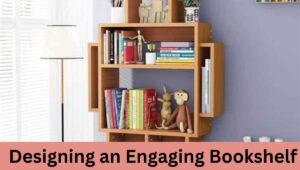
When we talk about designing an engaging bookshelf, we mean making it interesting and exciting for kids. Imagine it like setting up a mini library just for them! To do this, we choose books that match their interests and put them on the shelf in a way that makes them easy to see and reach.
Choosing the Right Books
The first step is picking books that kids will really enjoy. These can be about animals, adventures, mysteries, or anything they like. It’s like selecting toys that they love to play with.
Organizing the Books
Next, we organize the books in a neat and tidy way. We can put similar books together, like all the animal books in one section and adventure stories in another. This helps kids find the type of book they’re in the mood for.
Making it Colorful and Attractive
We can also make the bookshelf colorful and attractive. Maybe we use bright book covers that catch their eye. This makes the bookshelf look inviting and fun.
Kid-Friendly Height
It’s important to put the books at a height where kids can easily reach them. This way, they can pick a book whenever they want to read without needing help.
Changing the Books Sometimes
To keep things exciting, we can change the books on the shelf every once in a while. This is like adding new toys to their playtime. Kids get curious about what’s new and want to explore.
How can bookshelves reflect Montessori principles like choice, autonomy, and freedom within limits?
Reflecting Montessori Principles in Bookshelves
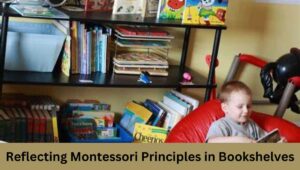
Montessori principles are like special ideas that help kids learn and grow in a wonderful way. When we talk about bookshelves reflecting these principles, it means setting up the shelves to help children make their own choices, feel independent, and learn within safe limits.
Choice
Imagine going to a candy store and getting to choose your favorite candy. Montessori bookshelves work a bit like that. Kids can choose the books they like from the bookshelf. This makes them feel happy and excited because they’re getting to decide what they want to read. It’s like giving them the power to pick what interests them.
Autonomy
Autonomy is a big word that means having the freedom to do things on your own. Montessori bookshelves give kids the freedom to pick out books by themselves. They don’t need to wait for someone else to tell them what to read. This helps them become confident and feel proud that they can do things independently.
Freedom Within Limits
Imagine playing in a playground. You can run and play, but there are some rules to keep you safe, like not going too close to the edge. Montessori bookshelves also have limits. The limits are there to make sure kids have good and safe choices. For example, the books on the shelf are chosen to be interesting and helpful for learning. This way, kids have the freedom to choose from the books on the shelf, but the choices are guided by what’s best for them.
Strategies for creating a prepared environment.
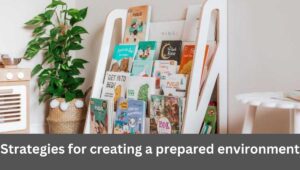
Creating a Reading-Friendly Space
Making a special place for reading is like creating a cozy spot where books feel like the best friends. You can put soft pillows or a comfortable chair in a quiet corner. This helps kids feel excited and relaxed when it’s time to read.
Displaying Books Nicely
Imagine arranging your toys neatly on a shelf so you can see and choose easily. That’s what we do with books too. We put them in a way that their covers can be seen. This makes kids curious and helps them pick books they like.
Choosing Interesting Books
Just like picking your favorite snacks, we choose books that are interesting to read. These can be about things you love, like animals, adventures, or space. When the books are exciting, reading becomes enjoyable.
Rotating Books Sometimes
Imagine having different toys to play with every week. It’s the same with books. We can change the books on the shelf every now and then. This makes reading feel like a surprise and keeps it fun.
Adding Variety
Think about having different flavors of ice cream. Books can be like that too. We can have storybooks, books with pictures, and books with facts. This way, kids can explore different kinds of reading.
Sharing Reading Time
Reading can be more fun when it’s done together. Parents, grandparents, or friends can join in. It’s like having a mini reading party where everyone enjoys stories.
Talking About Books
Imagine talking about your favorite game or movie with friends. We can do the same with books. Talking about the stories we read helps us understand them better and makes reading even more interesting.
Being a Reading Role Model
When grown-ups read, it shows kids that reading is cool and important. They learn from what they see, so when they see you enjoying books, they’ll want to read too.
Making It Feel Special
Sometimes, adding a little magic makes things special. Reading under a blanket fort or with a flashlight can turn reading time into an adventure.
Listening and Choosing: When kids help choose the books for the shelf, it makes them excited to read them. It’s like being part of a team that creates fun reading moments.
Sourcing and Selecting Books
Sourcing Books
Sourcing books means finding them from different places so we can have a bunch of really good ones to read. Books are like treasure, and we want to find the best treasures!
Library Trips
Going to the library is like going on a book adventure. Libraries have many books that you can borrow and read. It’s like having a big collection of stories to choose from.
Bookstores
Bookstores are places where you can buy books. You can visit a bookstore and see what books they have on their shelves. It’s like a shop full of stories waiting for you.
Online
The internet is like a huge book world. You can find books online that you can read on a computer, tablet, or even print out. It’s like having a library right on your screen.
Selecting Books
Selecting books is like picking out the best ones from a big box of chocolates. We want to choose the books that are interesting, helpful, and fun to read.
Interesting Topics
We pick books about things that you like. If you love animals, you can choose books about animals. If you’re into space, there are books about planets and stars.
Good Pictures and Words
Books with nice pictures and words that are easy to understand are the best. Pictures make the story more exciting, and words help us learn new things.
Checking Reviews
Reviews are like little notes from people who read the book. They tell us if the book is good and if other kids liked it. It’s like getting advice from friends.
Ask Friends and Adults
Friends and grown-ups can suggest great books they enjoyed. It’s like getting recommendations from people you trust.
Matching Your Age
Just like clothes that fit you well, books should be a good fit for your age. If a book is too hard, it might be frustrating. If it’s too easy, it might not be interesting.
Creating Interactive Bookshelves
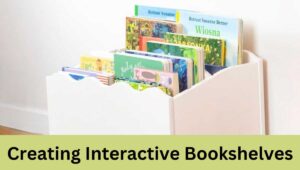
Interactive Bookshelves
Interactive bookshelves are like book friends that come with extra surprises. It’s not just about reading the words; it’s also about playing and exploring while you read!
Adding Props
Props are like special things that match the story in the book. If the story is about a farm, you can have toy animals. It’s like bringing the story to life with toys.
Puzzles and Activities
Imagine solving a puzzle that goes with the story. It’s like a game connected to the book. Activities make reading even more interesting and give you something to do along with the story.
Crafty Creations
Crafts are like creative projects that go with the book. If the story is about space, you can make paper rockets. It’s like making something cool while you read.
Engaging Games
Games that match the book’s theme make reading an adventure. If the story is about pirates, you can have a pirate treasure hunt game. It’s like playing a game that connects to the story.
Exploring with Your Senses
Imagine reading a story about the beach and feeling sand while you read. Interactive bookshelves can have things to touch, smell, or even taste that go with the story. It’s like using all your senses to enjoy the book.
Dressing Up
Sometimes, dressing up like characters from the book can be super fun. If the story is about astronauts, you can wear a space helmet. It’s like becoming part of the story.
Sound Effects
Adding sounds that match the story can make it feel real. If the story is about rain, you can play soft rain sounds. It’s like creating a mini movie in your mind.
Creating Your World
Interactive bookshelves let you dive into a world that’s not just on the pages. It’s like stepping into a magical land that the book describes.
Sharing with Friends
Interactive bookshelves can be shared with friends. You can all enjoy the surprises together. It’s like having a playdate with stories.
Role of the Adult and Observation
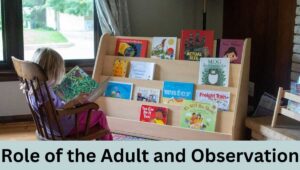
Role of the Adult
Grown-ups, like parents and teachers, have an important part to play when kids are reading. They’re like helpful guides on a reading adventure.
Listening and Helping
Adults can listen when kids read or want to talk about a story. They can help with tricky words or answer questions. It’s like having a reading buddy who’s always there to support.
Choosing Good Books
Grown-ups can help pick books that are just right for you. They know what you like and what can help you learn. It’s like having someone who knows your taste in stories.
Reading Together
Reading with adults can be fun. You can take turns reading pages or even act out parts of the story. It’s like having a fun playtime with words.
Showing Excitement
When adults show they’re excited about reading, it makes you excited too. Their smiles and enthusiasm make you want to dive into books.
Observation
Observation means watching and paying attention to how things are going. Adults observe when you read to understand how you’re doing and how they can help.
Noticing What You Love
Grown-ups watch to see which books you enjoy the most. They notice what topics make you curious and what stories make you smile.
Seeing Progress
When you read, adults can see how you’re getting better. They notice when you read faster, understand more, and use new words.
Discovering Challenges
If there’s something tricky in your reading, adults notice. They might see if there are words you find difficult or parts of the story that confuse you.
Adapting Support
By observing, adults know how to help you better. They adjust their support based on what they see. It’s like having a personalized coach for reading.
Encouragement
When grown-ups observe your progress, they can cheer you on. They celebrate your achievements, making you feel proud and motivated.
Taking Care of Books and Showing Respect
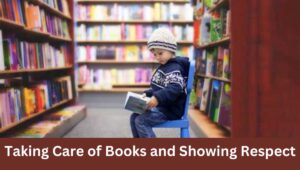
Book Care
Taking care of books is like taking care of your favorite toys. When you treat books gently and nicely, they stay in good shape and last longer.
Clean Hands
It’s a good idea to have clean hands before you touch books. Clean hands keep the pages clean and free from smudges or dirt.
Turning Pages Carefully
When you turn the pages, do it gently. It’s like treating the pages like delicate treasure. Turning them roughly can tear the pages.
No Food or Drinks
It’s better not to eat or drink while reading. Food and drinks can accidentally spill and make the book messy.
Keeping Away from Water
Books and water don’t get along. It’s important to keep books away from water to keep them dry and safe.
Using Bookmarks
Bookmarks are like friends that keep your place in the story. Using bookmarks instead of folding the pages helps keep the book neat.
Storing Properly
When you’re done reading, find a safe spot for your book. This can be on a bookshelf or in a special place. Storing it carefully prevents damage.
Respecting Books
Respecting books means treating them with care and understanding their value. Books are like friends that share stories and knowledge with us.
Reading with Care
When you read, show kindness to the book. Hold it gently and turn the pages with care. It’s like giving the book your attention.
